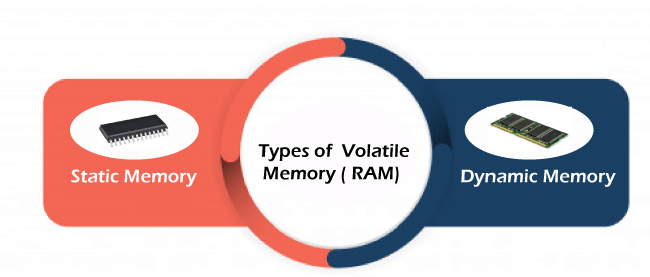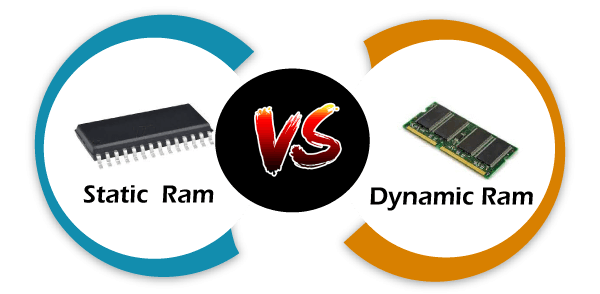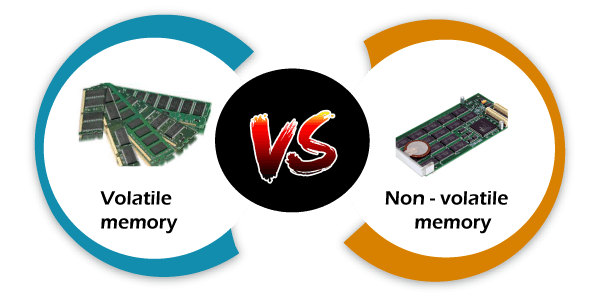Volatile Memory
Volatile memory is a type of computer storage which requires a continuous electric current to maintain its saved data.
This memory only keeps the stored data till the system is powered. When there is no electric power in the system, the data automatically erases from the computers.
In desktop and laptop computers, 'Random Access Memory (RAM)' is a volatile memory. The read and write operations on RAM are faster than the hard disk and solid-state drive. That's why the computers, tablets, mobiles, and other electronic systems used RAM for high-speed data access.
When we are working on a document in our computer systems, the document is kept in RAM, and when the computer is turned off, the random access memory automatically loses its documents. If we want to save our documents from erasing, then we should save our files and documents in non-volatile memory, such as hard disks, optical disks, and removable disks.
Types of Volatile Memory (RAM)
The types of volatile memory require continuous electric power for the proper processing of computer operations. Volatile memory is categorized into two different types of RAM:
- Static RAM
- Dynamic RAM

Static RAM
Static RAM is a type of volatile memory (RAM) which is mainly used in microprocessors and electronics. It is a form of semiconductor memory which does not require to be refreshed on a regular basis. This RAM keeps its content as long as the electricity is being supplied to the systems.
It is a simple random access memory. This type of volatile memory uses flip-flops for storing each data bit.
This RAM also loses its data when the electric power is disconnected from the system. It consumes less electric power and is used as cache memory. This memory is faster than the other parts of volatile memory.
Characteristics of Static RAM
The main characteristics or features of Static Random Access Memory are mentioned below:
- The main characteristic is that there is no need to refresh the memory on a regular basis.
- Static Random Access Memory is widely used in workstations, desktop computers, printers, routers, and computing applications.
- The life of static RAM is long.
- This type of RAM is faster.
Advantages of Static RAM
The important advantages of SRAM are given below:
- Reliability is the most important advantage of static RAM. This type of memory is used as cache memory in your desktop and laptop computers.
- This type of volatile memory consumes less power and provides high performance.
Disadvantages of Static RAM
The disadvantages of Static RAM (volatile memory) are given below:
- In comparison to dynamic random access memory, it is expensive.
- The design of static RAM is complex.
- The nature of SRAM is volatile, i.e., the memory loses its content when the system is unplugged from the power.
- The storage amount in SRAM is less than DRAM.
Dynamic RAM
Dynamic RAM is another type of volatile memory(RAM) which is composed of millions of transistors and capacitors. It is also another form of semiconductor memory that requires to be refreshed continuously.
This type of RAM loses its data in a very short time, even when the power of the system is on. This memory is used as the main memory because it is small and less expensive.
Advantages of Dynamic RAM
The important advantages of DRAM are given below:
- The main benefit of dynamic RAM is that its cost is less than static RAM. That's why this is used as main (primary) memory.
- In comparison to static RAM, the design and architecture of dynamic RAM are simple.
- The memory of dynamic RAM can be easily deleted and refreshed at the time of program execution.
- The size of dynamic RAM is small and able to store a large amount of data in storage.
- This RAM consumes less power.
Disadvantages of Dynamic RAM
The disadvantages of dynamic RAM (volatile memory) are given below:
- The main disadvantage of dynamic RAM is that the speed of accessing data is slow as compared to the static RAM.
- Another disadvantage is that the content on this RAM needs to be refreshed regularly.
- In comparison to static RAM, it consumes high power for proper functioning.
Difference Between Static RAM and Dynamic RAM

| Static RAM (SRAM) |
Dynamic RAM (DRAM) |
| 1. Static RAM uses flip-flops for storing each bit of data. |
1. Dynamic RAM uses capacitors within an integrated circuit for storing each bit of data. |
|
| 2. The size of static RAM varies from 1 Megabyte to 16 Megabyte. |
2. The size of dynamic RAM varies from 1 gigabyte to 6 gigabytes in tablets and smartphones and 4gigabyte to 32 gigabytes in desktop computers and laptops. |
|
| 3. The access time of static RAM is less. That's why it is faster than dynamic RAM. |
3. The access time of static RAM is high. That's why it is slower than static RAM. |
|
| 4. This type of RAM is a cache memory which works between the primary memory and process. |
4. This type of RAM is used as main memory, which works on the system's motherboard. |
|
| 5. The capacity for storing the data in static RAM is less than the dynamic RAM. |
5. The capacity for storing the data in dynamic RAM is high than the static RAM. |
|
| 6. Flip-flops and transistors are used in this volatile memory. |
6. Capacitors and some transistors are used in this volatile memory. |
|
| 7. Static RAM does not need to be refreshed regularly because there is no capacitor. |
7. Dynamic RAM needs its content to be refreshed regularly. |
|
| 8. Static RAM stores the data in the form of voltage. |
8. Dynamic RAM stores the content in the form of charge. |
|
| 9. Static RAM consumes less electric power for proper processing. |
9. Dynamic RAM consumes high electric power for proper processing. |
|
| 10. The requirement of hardware is less. |
10. Dynamic RAM requires extra hardware for refreshing. So, its architecture is complex. |
|
| 11. As compared to dynamic RAM, the cost of static RAM is high because of the high speed. |
11. While the cost of static RAM is less. So, anyone can easily afford it. |
|
| 12. The latency of static RAM is lower than dynamic RAM. |
12. The latency of dynamic RAM is high than the static RAM. |
|
| 13. Static RAM generates more heat in comparison to dynamic RAM. |
13. Dynamic RAM generates less heat in comparison to static RAM. |
|
What is Non-Volatile Memory
Non-volatile memory is another type of computer storage which keeps its saved content even when the system is powered off.
This type of memory is also known as permanent storage, long-term, and persistent storage. Hard disk, flash drive and Read Only Memory are the best examples of this type of memory.
This type of memory also stores the time and settings of your computer system even when the electric current is off.
Differences between Volatile and Non-volatile memory
Both memories allow you to store the data. But, there are a lot of differences between both memories. The differences are discussed in the following table:

| Volatile Memory |
Non-Volatile Memory |
| 1. Volatile memory is the type of memory which only kept its content when the system is turned on. When the system is powered off, the content automatically erases. |
1. Non-volatile memory is another type of memory which keeps its data even when the system is powered off. |
| 2. Volatile memory stores its data and information temporarily. |
2. Non-volatile memory permanently stores the data in the storage. |
| 3. In comparison to non-volatile memory, the performance of this memory is faster. |
3. In comparison to volatile memory, the performance of this memory is slower. |
| 4. The best example of volatile memory is RAM (Random Access Memory). |
4. The best example of non-volatile memory is ROM (Read Only memory). |
| 5. In comparison to non-volatile memory, volatile memory easily transfers the data. |
5. While the transfer of data in this memory is difficult. |
| 6. Both read and write operations are performed in volatile memory. |
6. Only read operation is performed in non-volatile memory. |
| 7. In comparison to non-volatile memory, its storage capacity is less. |
7. In comparison to volatile memory, this memory stores a huge amount of data. So, it has more storage capacity as same as the HDDs. |
| 8. Volatile memory, i.e., RAM, stores the data of the operations which are currently performed by the CPU. |
8. Non-volatile memory stores any kind of data permanently. |
| 9. This type of memory is expensive per unit size. |
9. While its cost is less per unit size. |
| 10. Volatile memory affects the performance of the computer system. |
10. While ROM has no impact on the performance of the system. But, it has a huge impact on the storage capacity of the systems. |
| 11. Processor has direct access to data in the volatile memory. |
11. Processor has no direct access to data in the non-volatile memory. |
| 12. The chips of RAM are generally embedded in the memory slot. |
12. The chips of non-volatile memory are kept on the system's motherboard. |
Advantages of Volatile Memory
The advantages of volatile memory are discussed below:
- The main advantage of volatile memory is that it is fast. It can perform read and write operations fastly on the systems.
- Another best advantage is that this type of memory consumes less electric power as compared to the hard disk and other drives.
- Volatile memory increases the speed of our computers and other electronic systems. The system performs operations fastly if it has more RAM.
- In comparison to non-volatile or secondary memory, the speed or performance of this memory is faster.
- This type of computer memory stores the data for processing on a central processing unit.
Disadvantages of Volatile Memory
The disadvantages of volatile memory are discussed below:
- Less RAM or volatile memory minimizes the speed of desktop and laptop devices.
- If the CPU wants to access the data from volatile memory, then the speed of the system is slow. So, the CPU accesses the data from cache memory for maintaining the system's speed.
- The space in volatile memory is less or limited.
- Cost is the big disadvantage of volatile memory. In comparison to secondary or non-volatile memory, these memories are expensive. So, some people cannot afford it because of its high cost.
- The main disadvantage of this memory is that it requires continuous electric power to retain its information.
| 


 For Videos Join Our Youtube Channel: Join Now
For Videos Join Our Youtube Channel: Join Now










